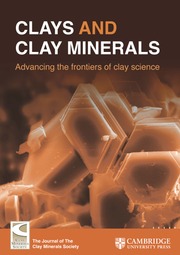Article contents
Identification of Neoformed Ni-Phyllosilicates Upon Ni Uptake in Montmorillonite: A transmission Electron Microscopy and Extended X-ray Absorption Fine Structure Study
Published online by Cambridge University Press: 01 January 2024
Abstract
The aim of this work was to investigate whether neoformed Ni-phyllosilicates can be observed and identified using transmission electron microscopy (TEM) in combination with energy dispersive spectroscopy (EDS). The investigations focused on Ni-phyllosilicates formed from Ni-doped montmorillonite. The reaction conditions (pH 8, [Ni]initial = 660 and 3300 µM, 0.2 M Ca(NO3)2) employed were similar to those used in previous polarized extended X-ray absorption fine structure (P-EXAFS) investigations of neoformed Ni-phyllosilicates in a Ni-montmorillonite system.
The TEM investigations of Ni-doped montmorillonite revealed the presence of small, thin particles consisting of coherent stacks that yielded only three to five lattice fringes with spacings consistent with smectites. These small particles were neoformed phyllosilicates, based on the fact that the small particles were only observed in Ni-doped samples and their Ni content, as determined from EDS analysis, was high (up to 10 wt.% NiO). Furthermore, the particles did not possess the characteristic properties of montmorillonite particles, such as a 2:1 Si to Al ratio; instead these particles were rich in Si (up to 75 wt.% SiO2). Unlike montmorillonite, these particles did not contain any Fe. The particles were also significantly more resistant to electron beam damage than montmorillonite particles, and EXAFS measurements confirmed the presence of neoformed Ni-phyllosilicates.
The TEM study further indicates the presence of a variety of additional minerals (e.g. cristobalite, halloysite) and an X-ray amorphous Si-rich phase. A Ni signal could only be detected in the latter phase at high Ni loadings (403 µmol/g), suggesting that Ni uptake at low metal loadings (<90 µmol/g) is mainly controlled by the neoformation of phyllosilicates.
Information
- Type
- Research Article
- Information
- Copyright
- Copyright © 2006, The Clay Minerals Society
References
- 16
- Cited by

